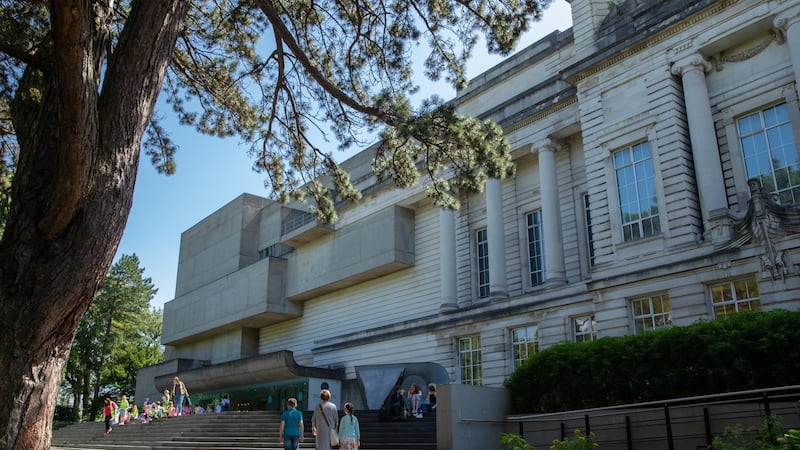Ireland’s cultural institutions have been closed for months, but behind the scenes of the dark theatres and inside the quiet halls of empty galleries a different kind of life has been going on. As our cultural institutions prepare to reopen, this new series takes a look at what’s involved, what to look forward to, and just how you make our arts spaces Covid-safe
People have been doing some wonderful work to get things online, but the medium has its limitations. Watching livestreamed theatre can feel like proof of life, rather than life itself. Virtual tours of galleries reminds that the work is waiting there – but even though a camera can zoom right in, it still feels a little diminished. Try as digital might, there’s nothing like the shared experience of the real thing, whether that’s getting up close and personal with a painting, or gathering in a theatre foyer with all the anticipation of the event to come.
At time of writing, museums and galleries are open, as are libraries (for lending services only) and heritage sites. In Northern Ireland, the reopening schedule is different, with museums and galleries set to reopen from May 24th.
In the meantime, theatres and cinemas must wait “until June”. While the Government’s “let’s see how this phase of reopening goes” approach is understandable, it’s a fluidity that is particularly troubling for theatres – as you can’t simply have a production “ready to go”. In the same boat, Ireland’s summer arts festivals are once again juggling cautious live events with online offerings, bringing great creativity to tackling such a tricky situation.
As time goes on, the hybrid blend of online, outside and small indoor will shift towards larger events and indoor capacities, and yet some things will stay. Online has given our galleries larger portals to a wider world, and livestream has opened up theatre to audiences both isolated and far flung. Rather than going back to “normal”, it’s a new world. And if the cultural sector can manage to stay afloat when the pandemic supports cut it adrift, it could be a very interesting world indeed.

Sprawling over 8,000 square metres, and with departments ranging from contemporary art to history, archaeology to zoology, the Ulster Museum is a fascinating place. During the prolonged closure, it's tempting to think of its darkened halls in terms of the Ben Stiller film Night at the Museum, imagining its wide collections becoming animated when no one is looking. This is especially vivid as general manager Ray Williams speaks of Takabuti, the museum's mummified body, originally hailing from Egypt (sometime between 790 BC and 656 BC), and given to the museum in 1835.
Williams says he has accidentally become something of an expert: this will be his third time reopening the Ulster Museum since the pandemic began. The first closure came on St Patrick's Day last year, with the reopening at the end of July. The second shutdown was just before Christmas, and Williams says the 139th Royal Ulster Academy exhibition was open for just seven hours. "And the Renoirs, they were only on display for a matter of weeks, it was disappointing," he says, with quiet understatement.
“I was on site initially,” he says, and agrees that there is an eerie atmosphere to a museum that hasn’t met visitors for some time. “One hundred per cent, especially on a Thursday afternoon with the lights off, it’s really strange.” Takabuti is one of his favourites, “but that’s more because of the reactions of the families. Because we’ve been here so long, what’s really lovely is the generations who come with their kids and grandkids, and they’ll say, ‘Yes, but wait till you see the mummy.’” Wandering the halls alone, might Williams himself pause for a chat with Takabuti? “Not that I’d be willing to admit to,” he says.
Building work
Behind the scenes at the museum, the team has used the pause of lockdown to get essential building work done. This comprised the vital things that keep a gallery going that you can’t immediately see, and projects that would otherwise have caused major disruption, including replacing floors and the major plant equipment that runs the environmental control systems. This work had been in the pipeline, but had been awaiting space in the schedules so as not to discommode visitors. Major public disruption as a surprise fringe benefit? Occasionally.
During the closure the key priority was ensuring the building and collections remained safe and secure, Williams says. Security and environmental monitoring patrols were increased, while other challenges included sorting out the IT systems so that office-based staff could operate from home, at the same time as finding ways to stay engaged with colleagues who would normally have been hard at work in public-facing roles.

A teams hub kept communications going, and over time morphed into a more social hub. “We even had a 20-day cold shower challenge,” says Williams happily, describing a team-building project.
The museum has a workforce of about 85, and is part of National Museums Northern Ireland, with more than 350 staff. “A general manager pulls all the strands together,” Williams says, a role that sounds as if it calls for a great deal of tact. “I think so, though I hope everyone agrees. You do have to be a diplomat. The majority of staff were furloughed,” he adds. The government’s 80 per cent support was topped up by the museum to maintain salary levels. “It seemed the right thing to do, and you have to keep an economy going.”
In preparation for reopening, a risk assessment looked at every aspect of the visitor journey – from booking (something which was new for the always free-to-visit museum) to leaving the building. “We wanted to sanitise the site, not the experience,” says Williams, “so we wanted to ensure we had the right control measures in place that wouldn’t detract from the experience of the visit.”
Cleaning regime
In fact, the team learned from the toilets, basing standardised cleaning regimes on what would be more normally used in hospital toilets as a benchmark for overall cleaning. Canvassing visitors before opening, the team had learned that toilets and cafes were the biggest concerns. Staff spaces were also reorganised, as well as a system of queue management put in place for public areas. Other innovations included a colour-coded system of lines to guide visitors around, based on areas of interest. “This worked much better than expected,” says Williams.
Now, almost all geared up and ready to go (again), does Williams and his team have a sense that this one is for real? “I think so. The difference is the rate of the vaccination process. That’s given the certainty. Now it feels like we’re in a good place.” And what does he think about the length of closure? “I guess it comes down to politics,” he concludes, sagely. “Our buildings are really safe, but if we were open, would more people use public transport? During the main lockdown, being closed felt like the right thing to do.”
There has been some to-ing and fro-ing, politically speaking, about whether we should currently be crossing the Border, in either direction. "I think it should be more joined up," says Williams. "People joke about whether the virus recognises the Border – but, to be honest, I've lost track of the ups and downs." Now, with the reopening imminent, what is Williams most looking forward to? "Having the lights properly on, and the noise of the public being around. When the lights go up it's a showcase."
The Ulster Museum reopens on Tuesday, May 25th










